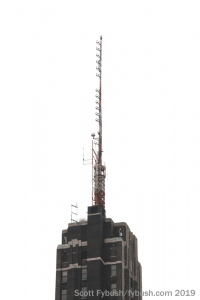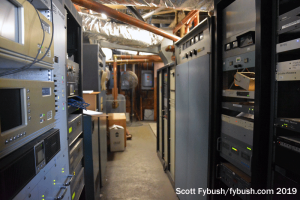NorthEast Radio Watch 12/23 & 12/30/2024: WKIT Lives!
In this week’s issue… WKIT finds a buyer - Eskin out at WIP - Staff shifts in Utica - CRTC approves Bell divestitures
Text and photos by SCOTT FYBUSH
What’s the most interesting and historic radio market in western New York? Not my own hometown of Rochester, alas – the answer to this question can be found an hour or so to the west, where there’s always something interesting to see and do (well, except right this very moment) in Buffalo.




I try to get over to visit my engineering friends there a few times a year, and last summer I had the pleasure of doing so in the company of old friend Mike Erickson, who was spending a few days up this way spreading his audio processing expertise far and wide.


Where to go with Mike? How about up to one of Buffalo’s tallest buildings, the Art Deco masterpiece on Lafayette Square called the Rand Building?
There is more broadcast history in this structure than just about anywhere else in town: not long after it opened in 1929, the Rand became home to the Buffalo Broadcasting Corporation, the near-monopoly that included stations WGR, WKEN, WMAK and WKBW. WMAK and WKEN didn’t stick around long: the WMAK broadcast license was spun off in 1930 to the Buffalo Evening News to become WBEN, while the WMAK calls moved to the WKEN facility, which was shut down not long afterward. But WGR and WKBW became two of the most significant stations in town, maintaining studios here through the 1940s before getting sold to separate owners and moving away.
Other radio stations moved in here to fill the void. With a spire ready-made for FM radio, the Rand’s tower became home to three new FM signals in the 1960s – WBLK (93.7), WBNY (96.1) and WADV (106.5). WBNY and WADV had their studios right here at the Rand, too – WBNY on the 17th floor, WADV on the 22nd floor and then on the fifth floor.




Consolidation eventually brought those three signals together under common ownership – Infinity, CBS Radio, Regent and now Townsquare – and today they, along with sister station WBUF (92.9), operate from the 13th and 14th floors of the Rand Building. 93.7 is still WBLK, the market’s top urban station, while 96.1 has become AC “Mix” WMSX (after many years as beautiful music/AC WJYE, “Joy”) and 106.5 sits at the top of the ratings as country WYRK.
The studios are split between the two floors, with a pair of mirror-image studios on each floor – Jack and WBLK on one, Mix and WYRK on the other.




Up the elevator, and then a flight of stairs, the transmitters for WBLK, WMSX and WYRK sit in an L-shaped configuration in the tight confines of the 27th floor. BE transmitters power the main signals of each of the three, with older Continental 816s as reliable backups – and a couple of even older RCAs still in place, too, all tended for many years by market veteran Bill Stachowiak.




That combiner? It pairs WBLK and WMSX into the top six-bay antenna, while WYRK has sole use of the lower six-bay. There are aux antennas down lower for all three. WBUF, meanwhile, uses the tower behind the Elmwood Avenue studios of WIVB-TV, a few miles to the north – which brings us to another bit of Buffalo history we spent some time exploring.
Look just a few blocks south from the Rand and you can see what remains of what was once a taller tower behind the Hotel Lafayette. This tower went up in 1953, an ambitious attempt to start a new UHF station, WBES-TV 59.
Like so many early UHF stations, WBES failed quickly and spectacularly, but its bones were soon picked over. The 428-foot tower at the Lafayette was repurposed for a new VHF station, WGR-TV (Channel 2), which signed on in 1954 as an ABC affiliate. WGR got NBC a few years later, after NBC’s own attempts at UHF in Buffalo had also failed – NBC shut down WBUF-TV (Channel 17), donating its license to a new educational TV outlet, which signed on in 1959 as WNED from the old WBES studio space at the Lafayette and from the tall tower NBC had built up on Elmwood behind what was supposed to have become the WBUF-TV showcase studios.
The studio building up there, however, ended up being sold to WBEN, which finished building it out and still occupies it today as WIVB-TV. The tower behind the studios was used by WNED until 1987, when it built its own even taller tower up on Grand Island. The Lafayette studios? They stayed in use until the mid-70s, when WNED moved to 184 Barton Street, which had been the WGR-TV studio location and had been shared with WBUF-TV, too. And the tower behind the Lafayette? That was used only for WGR-TV’s first few years, before it built its own much taller tower down in the hills south of Buffalo near Java.




We’d heard that the old WNED studios were largely intact on the top floor of the Lafayette well into the 1990s, but they’re gone now – the hotel has gone through a massive renovation, which we got a peek at during an Open Doors Buffalo event last summer. Imagine the days when UHF TV pioneers made their way through this lobby in the early 1950s…




One more bit of history completes our little Buffalo tour this time around: southeast of downtown on Seneca Street, the Larkin Terminal Building is the remaining piece of what was once a very significant architectural site: this industrial building was once the manufacturing hub of one of the city’s biggest companies, with the office side of things housed in an adjacent administrative structure designed by Frank Lloyd Wright.
Alas, that landmark structure was razed during urban renewal – but the manufacturing building survives and has been redeveloped for office use. That tower on its roof? It went up here in 1929 for WEBR (1310), the independent station that battled the Buffalo Broadcasting monopoly, and it remained in use by WEBR as it moved to 1340 in 1941. WEBR moved again in 1947, to 970 with a five-tower directional antenna to the south in Hamburg (it was later WNED’s AM station and is now religious WDCZ).
The tower on the Larkin got a second life in the 1960s, when Gordon McLendon moved his WYSL (1400) and WYSL-FM (103.3) up here from an earlier AM site a few blocks to the north; in 1978, those stations built a new tower near the 33/198 highway interchange on the north side of the city, and that was the last time there was full-power broadcasting up here, though a few LPTVs have used this site.
Thanks to Bill Stachowiak for the tours!
FOR SALE: Central New England AM Powerhouse with 50,000-watt nondirectional daytime potential to cover 5 million people.
Dennis Jackson – wwdj@optimum.net

Behold, the 2025 calendar!
We chose the 100,000-watt transmitter of the Voice Of America in Marathon, right in the heart of the Florida Keys. This picture has everything we like in our covers — blue skies, greenery, water, and of course, towers! The history behind this site is a draw, too.
Other months feature some of our favorite images from years past, including some Canadian stations and several stations celebrating their centennials (can you guess? you don’t have to if you buy the calendar!).
We will ship daily through Christmas Eve. Place your order now for immediate shipping!
This will be the 24th edition of the world-famous Tower Site Calendar, and your support will determine whether it will be the final edition.
It’s been a complicated few years here, and as we finish up production of the new edition, we’re considering the future of this staple of radio walls everywhere as we evaluate our workload going forward.
The proceeds from the calendar help sustain the reporting that we do on the broadcast industry here at Fybush Media, so your purchases matter a lot to us here – and if that matters to you, now’s the time to show that support with an order of the new Tower Site Calendar. (And we have the new Broadcast Historian’s Calendar for 2025 ready to ship, too. Why not order both?)
Visit the Fybush Media Store and place your order now for the next calendar, get a great discount on previous calendars, and check out our selection of books and videos, too!
And don’t miss a big batch of Queen City IDs next Wednesday, over at our sister site, TopHour.com!
Next week: TBA
In this week’s issue… WKIT finds a buyer - Eskin out at WIP - Staff shifts in Utica - CRTC approves Bell divestitures
In this week’s issue… WBUR backs off local talk - EMF's expansion in NY, nationally - Rochester broadcasters honored - Russell finds new PA radio home - Remembering Bruce Stevens - The new calendar's here!
In this week’s issue… Remembering WNY's Palvino, Harris - Will King sell Bangor stations? - Kay moves earlier - New signal on LI - Cumulus cuts hit PA, New England - Frizzell sells in NH
In this week’s issue… Saluting a small-town radio vet - Bell moves CP24 - Scott heads west - Burlington gets Air 1, "Experimental Radio" - Family Life heads down I-86